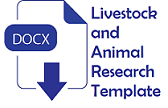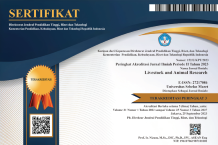Physical structure of leather tanned with aluminium as an alternative tanning agent
Abstract
Objective: This study aims to examine the physical structure of goat skins tanned with aluminium as an alternative tanning agent.
Methods: Twelve pieces of goat skin from the pikle breed were used in the study. Chromosal B, an aluminium tanning agent, Novaltan Al, salt (NaCl), Derminol OCS, MgO, Sodium bicarbonate, a BCG indicator, Permit MLN, and an anti-fungal are among the chemicals utilized. The approach involves tanning using chrome tanning as a control and aluminum tanning with amounts of 2%, 4%, and 6% Al2O3. Cross-sectional tests were used to assess the wet white leather's results, and the SEM-EDX method was used to determine the leather's composition.
Results: Leather tanned with aluminium tanning agent shows the distribution of aluminium in the skin section, the increasing use of aluminium tanning materials, the higher the aluminium content in tanned leather.
Conclusions: The presence of aluminium tanning agent in the skin indicates an interaction between the material and the skin so that it can be used as an alternative tanning agent.
Keywords
Full Text:
PDFReferences
- Buljan, J. and I. Kráľ. 2019. The framework for sustainable leather manufacture Second edition. United Nations. Available from: https://leatherpanel.org
- Thorstensen T. 1993. Practical Leather Tehnology. 4rd ed. Florida, New York: Robert E. Keiger Publishing Company Malabar; 1993.
- Crudu, M., V. Deselnicu, I. Ioannidis, L. Albu, and A. Crudu. 2012. New wet white tanning agents and technology. Proc. 4th Int. Conf. Adv. Mater Syst. ICAMS. 27–34.
- Zuriaga-Agustí, E., M. V. Galiana-Aleixandre, A. Bes-Piá, J. A. Mendoza-Roca, V. Risueño-Puchades, and V. Segarra. 2015. Pollution reduction in an eco-friendly chrome-free tanning and evaluation of the biodegradation by composting of the tanned leather wastes. J Clean Prod. 87:874–881. Doi: 10.1016/j.jclepro.2014.10.066
- Moussavi, G., F. Jiani, and S. Shekoohiyan. 2015. Advanced reduction of Cr(VI) in real chrome-plating wastewater using a VUV photoreactor: Batch and continuous-flow experiments. Sep. Purif. Technol. 151:218–224. Doi: 10.1016/j.seppur. 07.047
- China, C. R., M. M. Maguta, S. S. Nyandoro, A. Hilonga, S. V. Kanth, and K. N. Njau. 2020. Alternative tanning technologies and their suitability in curbing environmental pollution from the leather industry: A comprehensive review. Chemosphere. 254:126804. Doi: 10.1016/ j.chemosphere.2020.126804
- Kanagaraj, J., T. Senthilvelan, R. C. Panda, and S. Kavitha. 2015. Eco-friendly waste management strategies for greener environment towards sustainable development in leather industry: A comprehensive review. J. Clean Prod. 89:1–17. Doi: 10.1016/j.jclepro.2014.11.013
- Ockerman, H. W. and L. Basu. 2014. Hides and skins. Encycl. Meat Sci. 1:112–124.
- John, G. 1996. Possible defects in leather production. Lampertheim: Europaring 24 D-68623.
- Covington, A. 2009. Tanning chemistry the science of leather. Northampton: Royal Society Of Chemistry.
- Sreeram, K. J. and T. Ramasami. 2003. Sustaining tanning process through conservation, recovery and better utilization of chromium. Resour. Conserv. Recycl. 38:185–212.
- Madhan, B., B. U. Nair, and A. Fatmawati. 2001. Tanning agent based on mixed metal complexes of Aluminium and Zinc. J. Am Leather Chem. Assoc. 343–349.
- Bacardit, A., S. Van Der Burgh, J. Armengol, and L. Ollé. 2013. Evaluation of a new environment friendly tanning process. J. Clean Prod. 65:568–573. Doi: 10.1016/j.jclepro.2013.09.052
- Churchill, J. 1993. Tanning skins and furs. Stackpole Books. USA.
- Covington, A. D. and R. W. William. 2020. Tanning chemistry 2nd Edition. CPI Group (Ptd). Uk
- Anggriyani, E., L. Rachmawati, and N. P. Adetya. 2021. The use of non-chrome mineral tanning materials as a preferable environmentally friendly tanning material. Leather Footwear J. 21:173–182.
- Gao, D., Y. Cheng, P. Wang, F. Li, Y. Wu, and Lyu. 2020. An eco-friendly approach for leather manufacture based on P (POSS-MAA)-aluminum tanning agent combination tannage. J. Clean Prod. 257:120546. Doi: 10.1016/j.jclepro.2020. 120546
- Fuck, W. F., M. Gutterres, N. R. Marcílio, and S. Bordingnon. 2011. The influence of chromium supplied by tanning and wet finishing processes on the formation of Cr(VI) in leather. Brazilian J. Chem. Eng. 28:221–228.
- Raghava Rao J., N. K. Chandrababu, C. Muralidharan, B. U. Nair, P. G. Rao, and T. Ramasami. 2003. Recouping the wastewater: A way forward for cleaner leather processing. J. Clean Prod. 11:591–599.
- Krishnamoorthy, G., S. Sadulla, P. K. Sehgal, and A. B. Mandal. 2012. Green chemistry approaches to leather tanning process for making chrome-free leather by unnatural amino acids. J. Hazard Mater 215–216:173–182. Doi: 10.1016/j.jhazmat.2012.02.046
- Shi, J., R. Puig, J. Sang, and W. Lin. 2016. A comprehensive evaluation of physical and environmental performances for wet-white leather manufacture. J. Clean Prod. 139:1512–9. Doi: 10.1016/j.jclepro.2016.08.120
Refbacks
- There are currently no refbacks.










